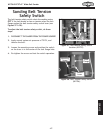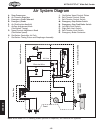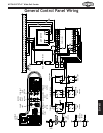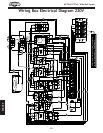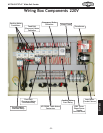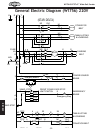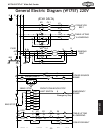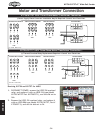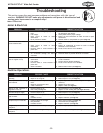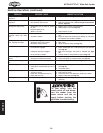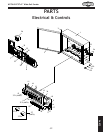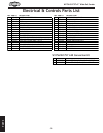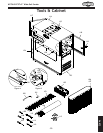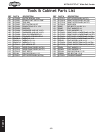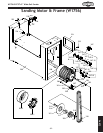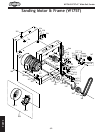
-55-
W1756/W1757 43" Wide-Belt Sander
SERVICE
Troubleshooting
This section covers the most common problems and corrections with this type of
machine. WARNING! DO NOT make any adjustments until power is disconnected and
moving parts have come to a complete stop
!
PROBLEM POSSIBLE CAUSE CORRECTIVE ACTION
Motor will not start.
1. Limit switch or emergency stop is at
fault.
2. Low voltage.
3. Open circuit in motor or loose
connections.
4. No air pressure to sander.
1. Correct situation that caused limit switch to engage, reset
the emergency stop button.
2. Check power line for proper voltage.
3. Inspect all lead connections on motor for loose or open
connections.
4. Connect sander to compressed air system (
Page 18).
Motor will not start; fuses or
circuit breakers blow.
1. Short circuit in line cord or plug.
2. Short circuit in motor or loose
connections.
3. Incorrect fuses or circuit breakers in
power line.
1. Inspect cord or plug for damaged insulation and shorted
wires.
2. Inspect all connections on motor for loose or shorted
terminals or worn insulation.
3. Install correct fuses or circuit breakers.
Motor overheats.
1. Motor overloaded.
2. Air circulation through the motor
restricted.
1. Reduce load on motor (see P
age 25).
2. Clean out motor to provide normal air circulation.
Motor stalls (resulting in blown
fuses or tripped circuit)
1. Short circuit in motor or loose
connections.
2. Low voltage.
3. Incorrect fuses or circuit breakers in
power line.
4. Motor overloaded.
1. Inspect connections on motor for loose or shorted terminals
or worn insulation.
2 Correct the low voltage conditions.
3. Install correct fuses or circuit breakers.
4. Reduce load on motor (see
Page 25).
OFF
PROBLEM POSSIBLE CAUSE CORRECTIVE ACTION
Machine slows when
operating.
1. Feed rate too high.
2. Depth of cut too great.
1. Feed workpiece slower (see
Pages 24).
2. Reduce depth of cut (see
Page 28).
Loud, repetitious noise coming
from machine.
1. Pulley set screws or keys are missing or
loose.
2. Motor fan is hitting the cover.
3. V-belt is defective.
1. Inspect keys and set screws. Replace or tighten if
necessary.
2. Tighten fan or shim cover.
3. Replace V-belt (see
Page 42).
Machine is loud, overheats or
bogs down in the cut.
1. Excessive depth of cut.
2. Dull or dirty sanding belt.
1. Decrease depth of cut
(see Page 28).
2. Replace or clean sanding belt (see
Pages 30 & 45).
Rounded workpiece edges. 1. Excessive depth of cut.
1. Reduce depth of cut
(see Page 28).
Uneven thickness from left to
right of board.
1. Feed table not parallel to sanding
roller.
2. Feed belt is worn.
1. Adjust the table
(see Page 38).
2. Replace feed belt (see
Page 43).
Workpiece slips on feed belt. 1. Pressure rollers set too high.
2. Dirty
feed belt.
3. Feed belt is worn.
1. Lower pressure rollers (see
Page 39).
2. Clean feed belt (see Page 30).
3. Replace
feed belt (see Page 43).
Straight strip of notches on
workpiece.
1. Pressure rollers are dirty or damaged. 1. Clean or repair pressure rollers.
Snake shaped marks on
workpiece.
1. Sanding belt damaged or dirty.
1. Clean or replace sanding belt
(see Pages 30 & 45).
Machine Operations
Motor & Electrical
Motor & Electrical



